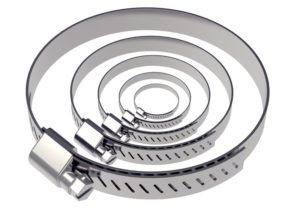 Hose clamps are without a doubt extremely useful and versatile — they can be utilized in everyday activities, and also in specialized mechanized fields, like the automotive and agricultural industries. Hose clamps help hoses of all kinds do their jobs by keeping a consistently pressurized sealant in place. They are used to attach and seal a hose onto a fitting such as a barb or nipple.
Hose clamps are without a doubt extremely useful and versatile — they can be utilized in everyday activities, and also in specialized mechanized fields, like the automotive and agricultural industries. Hose clamps help hoses of all kinds do their jobs by keeping a consistently pressurized sealant in place. They are used to attach and seal a hose onto a fitting such as a barb or nipple.
There is not, however, just one hose clamp out there. There are many hose clamp types — take a look at this list to find out which ones are for which uses.
Worm Gear Clamps
These hose clamps are made of galvanized or stainless steel slotted band with a screw hosing and adjustment screw. The clamps can be tightened or loosened by turning the screw with a flat-head screwdriver. They tend to be the most popular because they are versatile and easy to use. Indeed, worm drive hose clamps can be daisy-chained to make a longer clamp if several shorter ones do not have the length required.
Constant Torque Clamps
Constant-Torque clamps have a specific spring mechanism that eliminates “cold flow” leaks. They react to changes in temperature automatically, so as your system expands and contracts, the clamps will increase or decrease their diameter to maintain sealing pressure.
T-Bolt Clamps
These clamps have a smooth, wide stainless steel band and threaded t-bolt/nut adjustment to provide positive sealing pressure without damaging the hose. They are designed to function in high vibration and large diameter applications, like automotive, industrial equipment and agricultural machinery.
Marine Grade Clamps
These are very similar to standard worm gear clamps, but they are made using corrosion resistant 300 series stainless steel and are often the best choice for marine, underground, and corrosive environments. They also tend to have extra strong 4-piece interlocking constructions.
There are, of course, many other hose clamp types — mini hose clamps, plastic hose clamps, and wire hose clamps all fit the bill. Screw hose clamps are commonly used for fixing damaged pipes temporarily in emergency situations. Whatever your need, make sure you get the right hose clamp for the job or make sure to get a very general use clamp at first.

